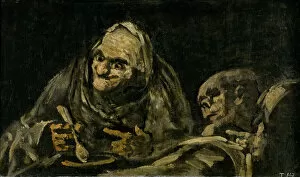Quinta Del Sordo Collection
"Quinta del Sordo: A Glimpse into Francisco Goya's Dark and Mysterious World" Step into the enigmatic world of Francisco Goya at Quinta del Sordo
All Professionally Made to Order for Quick Shipping
"Quinta del Sordo: A Glimpse into Francisco Goya's Dark and Mysterious World" Step into the enigmatic world of Francisco Goya at Quinta del Sordo, a place where his haunting visions came to life. This secluded villa served as the backdrop for some of his most iconic works, capturing the essence of human nature in all its complexity. One such masterpiece is "Pilgrimage to the Fountain of San Isidro, 1819, " which transports viewers to a spiritual journey filled with devotion and hope. Another captivating piece is "Judith and Holofernes, " showcasing Goya's ability to depict violence and power dynamics with raw intensity. Goya's fascination with societal norms is evident in "Procession of the Holy Office, " where he challenges religious authority through symbolic imagery. In contrast, "Two Old Men Eating Soup (The Witchy Brew)" portrays vulnerability and companionship amidst hardship. With "Man Mocked by Two Women (Women Laughing or The Ministration), " Goya explores themes of mockery and humiliation that resonate even today. His critical eye extends to politics in "The Reading (Politicians), " shedding light on corruption within those who govern. Venturing further into darkness, we encounter the eerie realm depicted in "Witches Sabbath or The Great He-Goat. " Here, Goya unveils our deepest fears and desires while questioning morality itself. Equally mesmerizing is his portrayal of destiny in "Atropos (The Fates). " "Asmodea or Fantastic Vision" takes us on a surreal journey through fantastical realms where reality blurs with imagination. Meanwhile, "Two Old Men (Two Monks)" captures moments of introspection as age brings wisdom but also isolation. Witnessing everyday life unfold against extraordinary backdrops can be seen in both "A Pilgrimage to San Isidro" and "Fight with Cudgels.













